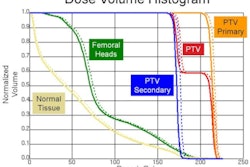Women with breast cancer whose treatment includes radiotherapy may experience persistent pain. Intraoperative radiotherapy (IORT) treatment does not seem to either increase or decrease this risk, according to a study published August 23 online in the journal Breast.
Patients who were enrolled in the Targeted Intraoperative Radiotherapy (TARGIT-A) clinical trial conducted at Copenhagen University Hospitals between March 2007 and January 2010 either received a single IORT treatment or conventional external-beam radiotherapy (EBRT) treatments. Patients were mailed a questionnaire assessing persistent pain and sensory disturbances of several thousand breast cancer patients who received treatment in Denmark. Of the 244 patients who received questionnaires, 98% responded. Ultimately, the analysis included responses from 112 patients in the EBRT arm of the clinical trial and 126 patients in the IORT arm.
Women in the EBRT group reported a 33.9% prevalence rate of pain compared with 24.6% in the IORT group. Pain localization was similar in the two groups, and pain intensity was low.
There were two differentiating characteristics, according to lead author Dr. Kenneth Geving Andersen, of the section for surgical pathophysiology and the section of acute pain management and palliation of the University of Copenhagen Rigshospitalet, and colleagues.
More than 20% of the EBRT group reported to have pain on a weekly basis compared with the IORT group (86.8% versus 64.5%). The researchers suggested that this might be attributed to the fact that there was a larger impact on nerves with a more extensive radiation field.
However, 15% more of the IORT group reported the prevalence of pain outside the treatment area than the EBRT group. This included neck and shoulder pain, low-back pain, and headaches, none of which could be pathophysiologically explained.



















